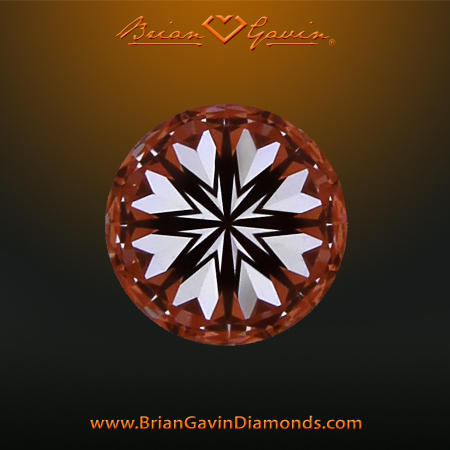
Reflecting upon Hearts and Arrows Diamonds
Hi Danny, I’m trying to decide between two Signature hearts and arrows diamonds, one is this 1.642 carat, H-color, VS-2 clarity, round diamond from Brian Gavin, and the other is , the proportions of the diamonds seem pretty similar to me, and I’m wondering how to determine which of the ideal cut diamonds is going to exhibit the highest volume of light return and the best sparkle. Any insight and suggestions that you can provide will be appreciated, since I imagine that your expertise will enable you to detect differences that I might miss. – Alan S.
Not all “Ideal Cut Diamonds” exhibit Hearts & Arrows:
The first thing that I want to point out is that not all round ideal cut diamonds exhibit a crisp and complete pattern of hearts and arrows; in fact, the majority of round brilliant ideal cut diamonds do not exhibit patterns of hearts and arrows by the grading standards established back in the 1990’s by gemological grading laboratories in Japan.
 So if you look at the photograph provided for the “Signature diamond” offered by the other vendor, which claims that their signature stones are hearts and arrows diamonds, you’ll see that the light which is reflecting off of the pavilion main facets to create the “hearts pattern” that reflects off of the lower girdle facets is irregular in shape, and that the distribution of light return is uneven, as demonstrated by how the left halves of the “hearts” pictured in the 12 – 1 and 3 o’clock positions are dark, while the right halves of the hearts are light in tone; this also occurs in the six o’clock position, but in a pattern which is reversed.
So if you look at the photograph provided for the “Signature diamond” offered by the other vendor, which claims that their signature stones are hearts and arrows diamonds, you’ll see that the light which is reflecting off of the pavilion main facets to create the “hearts pattern” that reflects off of the lower girdle facets is irregular in shape, and that the distribution of light return is uneven, as demonstrated by how the left halves of the “hearts” pictured in the 12 – 1 and 3 o’clock positions are dark, while the right halves of the hearts are light in tone; this also occurs in the six o’clock position, but in a pattern which is reversed.
While the vendor does not provide images of the diamond as seen through a hearts and arrows scope, it is also apparent that the length of the “heart” pictured in the twelve o’clock position is significantly longer than the heart featured in the one o’clock position; and that the size of the hearts varies dramatically as you move your eyes around the stone clockwise from that point; in addition, the clefts of the hearts also differ in length and depth.
If you compare the hearts pattern exhibited by this diamond in the pavilion photograph, with the hearts pattern exhibited by the Brian Gavin Signature round hearts and arrows diamond pictured above, I think that it is quite apparent that the hearts patterns of the two diamonds are dramatically different, and that only the Brian Gavin Signature diamond exhibits a pattern of hearts which would be considered to be crisp and complete by the majority of people, thus the standards for our Signature diamonds are as different as the volume of light return and sparkle factor are likely to be.
The effect of optical symmetry on hearts and arrows patterns:
The presence of a crisp and complete hearts and arrows pattern within a round brilliant cut diamond, is the direct result of extremely precise optical symmetry and diamond cut quality. In order for a hearts and arrows pattern to be created, the diamond cutter must shape and polish all of the facets on the diamond so that they are virtually identical in size, shape, and alignment; the alignment of the facets must not only be extremely precise in terms of how they are aligned from point to point, but also how they are positioned in relationship to each other in terms of the 360° view of the diamond, from top to bottom, and also across from each other.
The diagram presented above, was created by Brian Gavin to demonstrate how a hearts and arrows pattern is formed within a round brilliant cut diamond. The standard facet structure of a round brilliant cut diamond is outlined in orange, while the reflections of light that are necessary to create the pattern of hearts are colored green.
Each heart is actually comprised of the reflection of two halves, which are created as light reflects off of the pavilion main facet located on the opposite side of the diamond, across the diamond, on to the lower girdle facets opposite the pavilion facet; this is demonstrated on the diagram featured above using the pavilion main facet that is colored green in the 12 o’clock position, which is reflecting off of the lower girdle facets located in the relative six o’clock region of the diamond.
When light is reflecting unevenly across the facet structure of the diamond, it is evidence that the optical symmetry of the diamond is not as perfect as it could possibly be, thus the two “Signature diamonds” that you are considering are not comparable in my opinion.




















